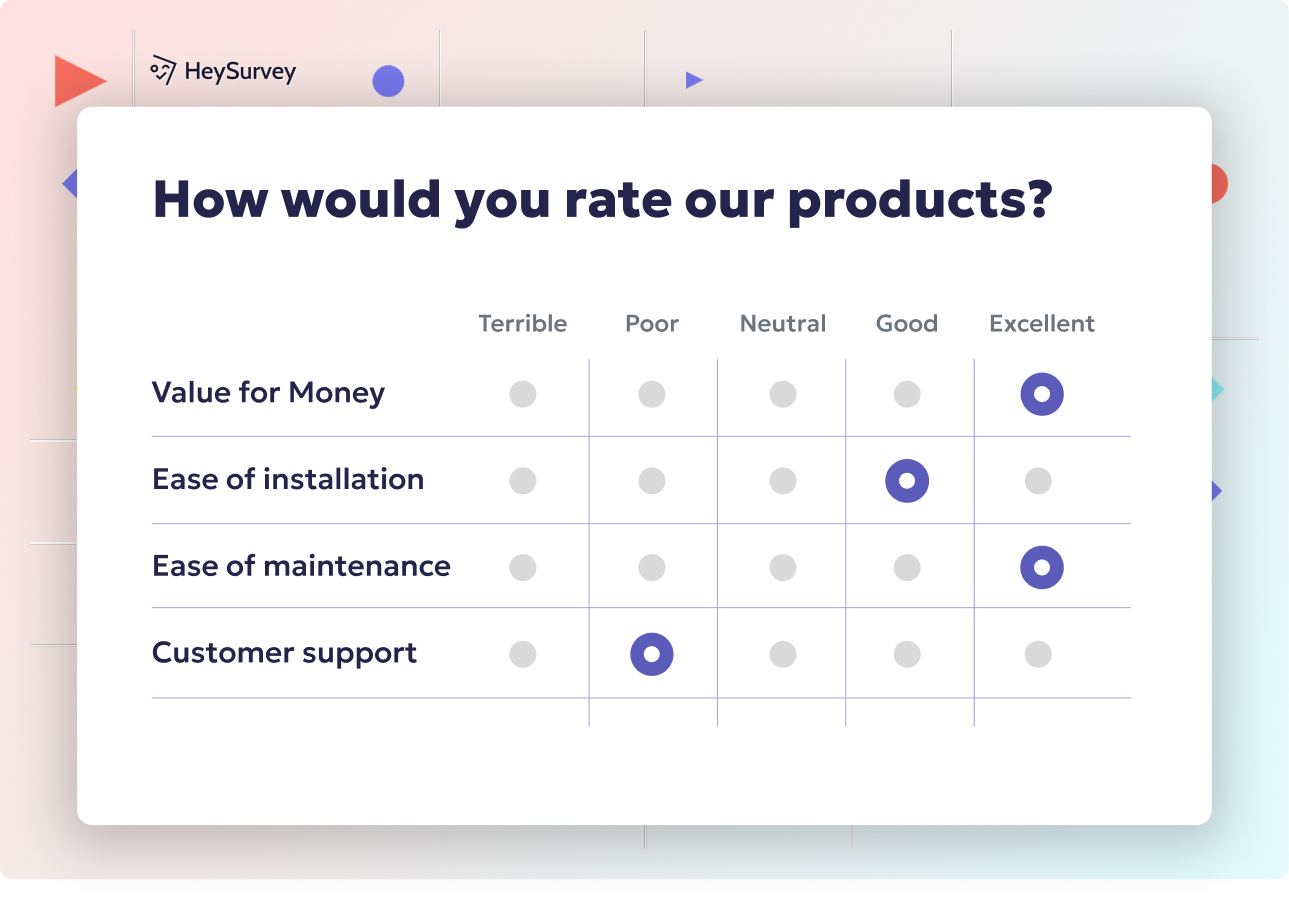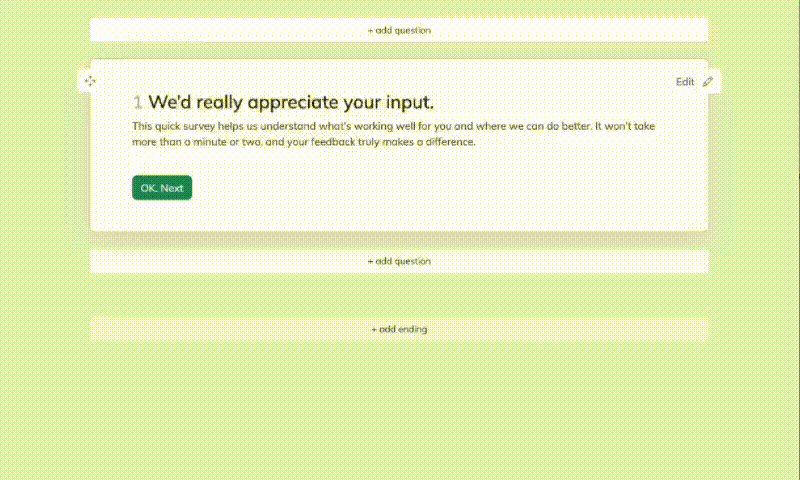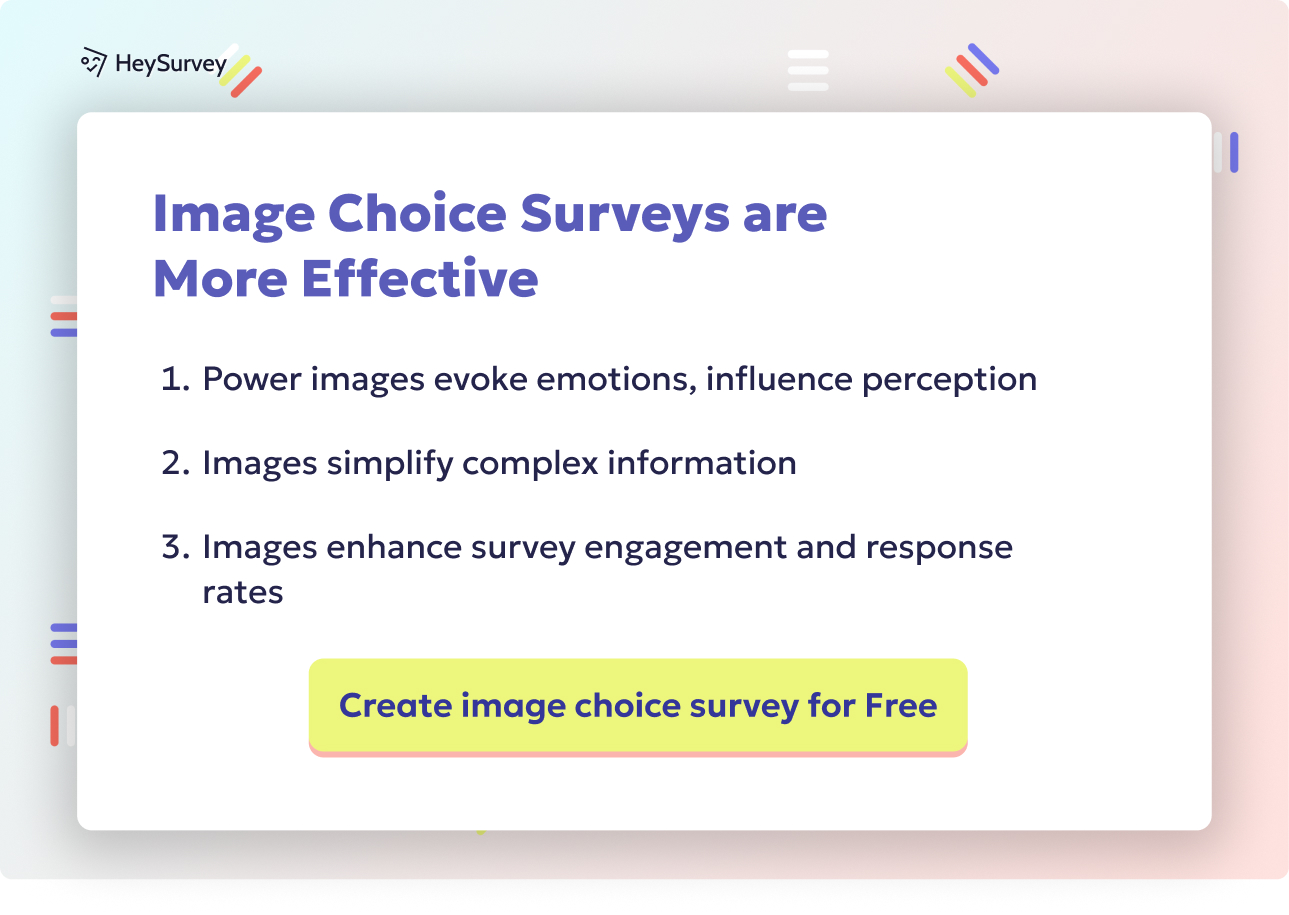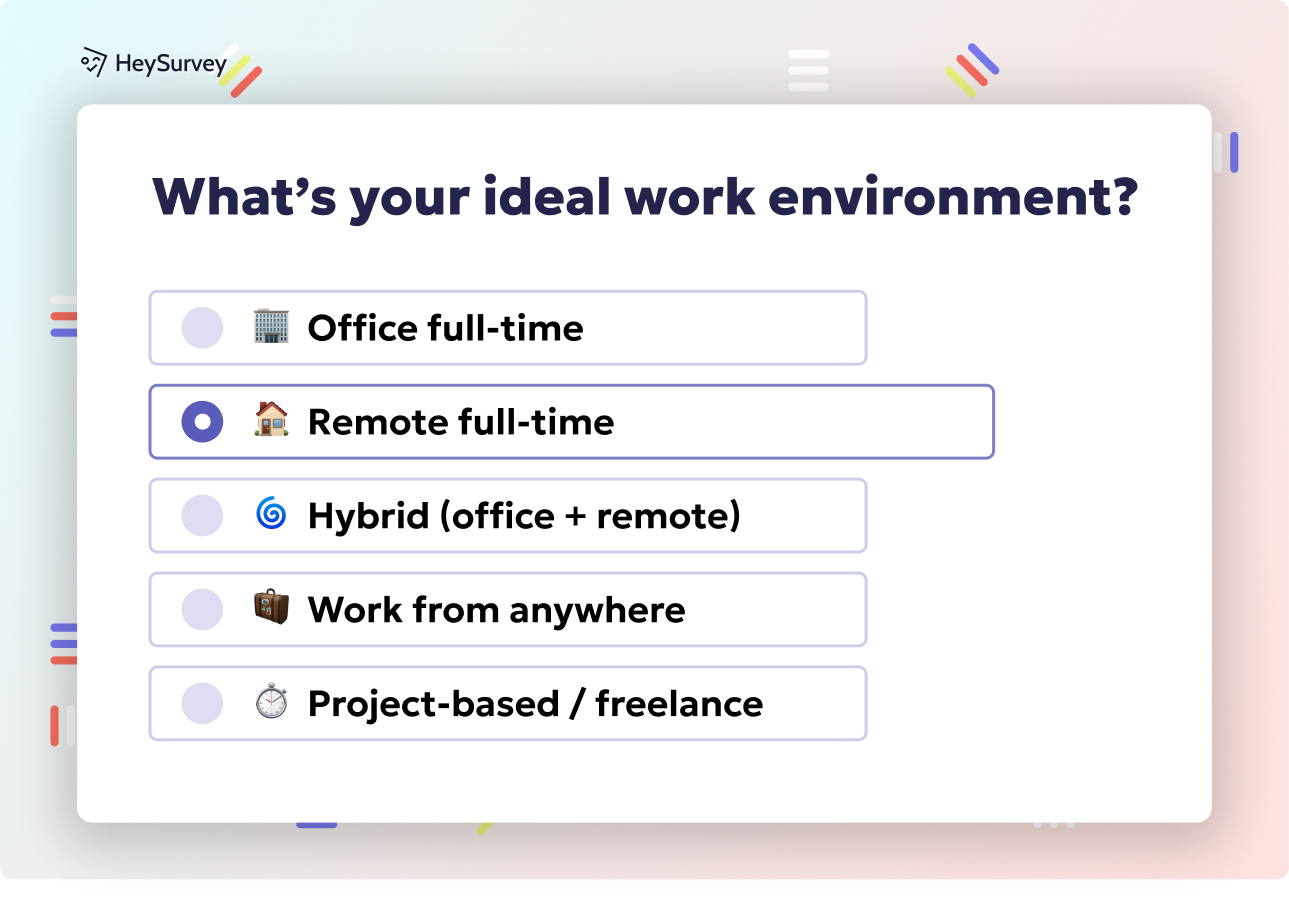29 Numerical Survey Questions: How, When & Why to Use Them
Explore how and when to use numerical survey questions with 35 sample questions covering scales, sliders, NPS, and more for clear insights.
Numerical survey questions are the unsung heroes of data-driven decisions. They turn fuzzy opinions into crisp digits, making results easy to analyze, compare, and visualize. Whether you’re tracking customer satisfaction, allocating resources, or plotting your product’s next big move, using the right numeric question is pure magic. Let’s explore what each type can do, why it works wonders, and how to use them with confidence.
Rating Scale Questions
Understanding the Basics
Rating scale questions are the bread and butter of survey research. These questions use numbers—such as 1 to 5, 1 to 7, or 0 to 10—to ask respondents to rate their experiences. The numbers form a linear or interval scale, which means the difference between each point is clearly defined and equal. Common formats abound:
- 5-point scale (e.g., 1 = Poor, 5 = Excellent)
- 7-point scale for extra nuance
- 11-point scale (0 to 10) for the fine-tuners among us
This structure is especially beloved for its simple, quantifiable data output. You can stack, chart, and crunch numbers like nobody’s business.
Why & When Should You Use Them?
Rating scales excel at quickly gauging perceptions—perfect for a sanity check or performance snapshot. They’re ideal when you need:
- Fast benchmarking
- Trends spotted over time
- Consistent answers that are easy to measure
They shine in tracking satisfaction, team performance, and product quality. If you need a numeric “vibe check,” this is the tool.
5 Sample Questions
On a scale of 1–10, how satisfied are you with our mobile app?
Rate the clarity of today’s webinar (1 = Not clear, 5 = Extremely clear).
How likely are you to re-purchase this product in the next 3 months (0–10)?
Evaluate the ease of navigating our website (1 = Very difficult, 7 = Very easy).
How would you rate the value for money of your subscription plan (1–5)?
Using a 10-point numerical scale in surveys enhances data precision and allows for advanced statistical analysis, making it particularly effective for measuring customer satisfaction. (tlfresearch.com)

How to Create a Numerical Survey with HeySurvey in 3 Easy Steps
Creating your first numerical survey with HeySurvey is a breeze—even if you’ve never touched a survey tool before. Follow these three simple steps, and you’ll go from blank page to published survey faster than you can say “data-driven insights.” Ready? Let’s roll.
Step 1: Create a New Survey
- Head over to HeySurvey and click “Create Survey” to start fresh.
- Pick either “Empty Sheet” if you want full control, or browse the pre-built templates designed for numeric questions to speed things up.
- Give your survey a snappy name so you’ll recognize it later.
- Voilà! The Survey Editor opens, ready to welcome your first question.
If you fancy, you can open a numerical survey template by hitting the button below this guide to see how it’s done in one click.
Step 2: Add Your Numerical Questions
- Click the big “Add Question” button at the top or between any existing questions.
- Choose the type that fits your needs—“Scale” for Likert, NPS, or rating scales; “Number” for age or income; “Choice” for constant sum allocation; or “Slider” for an interactive visual feel.
- Type your question text, set numeric ranges or labels, and mark questions “required” if you want answers from everyone.
- Spice it up with images or descriptions for clarity.
- Repeat adding questions to build your perfect survey flow.
Powered by HeySurvey’s flexible settings, you can customize each question’s numeric scale, set NPS scoring automatically, or allow detailed number inputs based on your research goals.
Step 3: Publish Your Survey
- Once your questions look good, hit “Preview” to see how respondents will experience your survey.
- Use the Designer Sidebar to tweak colors, fonts, or layouts to fit your brand vibe.
- When you’re happy, click “Publish”. You’ll need to create an account or log in if you haven’t already—it only takes a moment.
- Copy your shareable survey link or grab an embed code to pop it on your website.
- Share away and watch those numerical insights roll in!
Bonus Steps for Pro Results
Apply Branding: Upload your logo and adjust colors in the Branding panel to make your survey unmistakably yours. It builds trust and keeps respondents engaged.
Define Settings: Customize survey start/end dates, response limits, and redirect URLs in the Settings Panel. Control who sees it and when, plus what happens after submission.
Skip Into Branches: Use HeySurvey’s clever branching to tailor question flow based on answers. For example, if a respondent rates satisfaction low, you can instantly ask for detailed feedback—making your data richer and your survey smarter.
With these steps, you’re all set to build clear, effective numerical surveys that your audience will enjoy and you’ll learn tons from. Click that template below and start crafting your first numerical question today!
Net Promoter Score (NPS) Questions
What Makes NPS Special?
The Net Promoter Score question is a legend in customer loyalty circles. It asks customers one simple question on a 0–10 scale: “How likely are you to recommend us?” Answers bucket customers into three camps—detractors (0–6), passives (7–8), and promoters (9–10). This segmentation turns fuzzy opinions into strategic opportunities.
What makes NPS powerful is its industry-standard benchmarking capacity. Executives love it, analysts trust it, and dashboard widgets thrive on it.
Why & When to Use NPS
NPS shines as a key performance indicator. It’s best deployed:
- Right after a purchase or major interaction
- As a pulse-check for customer loyalty
- When tracking improvements over time
Use it when you need a memorable, comparable, and boardroom-ready score for your organization’s performance.
5 Sample Questions
How likely are you to recommend our brand to a friend or colleague?
How likely are you to recommend our customer service team?
How likely are you to recommend our new feature set?
How likely are you to recommend participating in our loyalty program?
How likely are you to recommend our online knowledge base?
Companies in the top NPS quartile achieve 25% higher revenue growth than competitors, with promoters generating 1.5 times more revenue than detractors. (lbstudio.sk)
Likert-Type Numeric Agreement Questions
Breaking Down Likert Scales
A Likert-type question translates opinions like “strongly agree” or “strongly disagree” into tidy numbers. Scales usually run from 1–5 or 1–7, and each number is labeled with a sentiment, creating a numeric form of attitudinal measurement. Treat the data as ordinal: we know what’s higher or lower, even if gaps between numbers aren’t always identical.
This setup is perfect for composite scoring across multiple statements, putting a number to feelings and attitudes.
Why & When to Choose Likert Numerics
Use these questions when you want to capture attitude strength or behaviors. They’re fantastic for:
- Psychometric tests
- Index-building
- Factor analysis across a set of related ideas
If you crave stats beyond a single item and want to group multiple items for a deeper dive, Likert numerics are ideal.
5 Sample Questions
Please rate your agreement: “The product is easy to install.” (1–5)
Customer support responds promptly. (1–7)
I feel confident using the dashboard. (1–5)
The price matches the value received. (1–7)
I would recommend this feature to others. (1–5)
Semantic Differential Numeric Questions
What Are They?
Semantic differential questions present you with two opposing adjectives at each end of a scale (think: “Boring” vs “Exciting”). Respondents choose a number that best reflects their impression, with endpoints clearly labeled.
This type provides a bipolar numeric anchor, letting you map perceptions across several attributes and see where a brand or product stands.
Why & When to Use Semantic Differentials
Unleash semantic differentials for serious brand profiling. They’re tailor-made for:
- Brand personality assessments
- Plotting competitive brand maps
- Concept testing (before launch!)
If you want nuanced insight into how something is perceived—across multiple planes—look no further.
5 Sample Questions
Rate our brand on the following scale: Boring (1) – Exciting (7).
Unreliable (1) – Reliable (7).
Traditional (1) – Innovative (7).
Complicated (1) – Simple (7).
Low quality (1) – High quality (7).
Semantic differential scales effectively measure attitudes by capturing evaluation, potency, and activity dimensions, providing nuanced insights into perceptions. (simplypsychology.org)
Constant Sum (Allocation) Questions
What’s the Idea?
A constant sum question asks people to divvy up a set number of points, credits, or percentages among several options. It’s an instant window into their priorities and trade-offs. For example, they might distribute 100 points across potential product features.
This forces clear, relative importance judgments, rather than just rating everything on its own.
Why & When to Use Constant Sum
Call in the constant sum champion when:
- You’re curious about trade-offs and priorities
- Budget allocation or resource division matters
- Weighted composite scores are in play
It’s a favorite for marketers, HR professionals, and anyone who must balance demands and choose winners.
5 Sample Questions
Allocate 100 points across these product features based on importance.
Distribute your monthly tech budget (100%) among the following services.
Assign 100 credits to the marketing channels you use.
Divide 10 hours of weekly training time among these skills.
Spread 100 tokens across the causes you care about.
Ratio / Absolute Numeric Input Questions
Defining Ratio Questions
Ratio or absolute numeric questions ask for exact numbers—like age, income, units, or distances. These fields have a true, meaningful zero and no upper limit besides reality (and user patience). No bins or brackets here: just pure, unfiltered numerals.
Such questions yield data that plays well with advanced analytics—everything from averages to regressions, clusters, and segmentations.
Why & When to Use These Inputs
Deploy this format for:
- Demographic profiling (precise ages, incomes)
- Spend analysis or true market sizing
- Any scenario where precision and mathematical analysis matter
These questions also make life easier for dashboard enthusiasts who love their metrics tidy.
5 Sample Questions
What is your age in years?
How many units of our product did you purchase last month?
What is your annual household income in USD?
How many hours per week do you work remotely?
What is the distance you commute to work (miles)?
Slider (Visual Analog) Questions
What’s a Slider Question?
Slider (visual analog) questions are interactive delights for respondents. Instead of typing a number, you drag a handle along a bar to select a value within a range (like 0 to 100). Sliders can capture both whole numbers and decimals, letting you record subtle feelings and preferences.
They’re a winner for their engaging, mobile-friendly user experience and their ability to nudge people toward giving more accurate, nuanced answers.
When Are Sliders the Right Move?
Sliders thrive in surveys that:
- Need continuous, not choppy, data
- Are mobile-first or prioritize modern UX
- Tap into feelings or states that change fluidly (think stress, confidence)
If your audience is short on patience but keen on swiping, go for sliders!
5 Sample Questions
Drag the slider to indicate your current stress level (0–100).
How confident are you about the new feature? (0 = Not at all, 100 = Extremely)
Set your ideal monthly subscription price ($0–$100).
Indicate your satisfaction with the interface (0–10).
Adjust the slider to show your likelihood of attending future webinars (0–100).
Demographic Numeric Questions
What Counts as Demographic Numerics?
Demographic numeric questions capture vital stats beyond age or income—think household size, years of experience, or the number of flying miles. These numbers feed directly into market segmentation, targeting, and weighting.
Their real magic comes in allowing crystal-clear crosstabulation and audience profiling, as every number adds a cuttable, sliceable dimension for the analyst.
When to Use Demographic Numerics
Always include these questions:
- At survey’s end, to minimize drop-off
- When you need rock-solid sample segmentation
- For weighting results to match real-world populations
They’re essential ingredients in almost any research recipe.
5 Sample Questions
How many people live in your household?
How many years have you worked in your current industry?
How many children under 18 live with you?
How many times have you flown in the past 12 months?
How many connected devices do you own?
Best Practices, Dos & Don’ts for Numerical Survey Questions
Dos
When crafting numerical survey questions, follow these best practices:
- Keep scales consistent throughout your survey to avoid confusion.
- Label your scale endpoints clearly (e.g., 1 = Poor, 5 = Excellent).
- Pre-test your question ranges to identify ambiguity.
- Provide context for every question.
- Randomize option order when it’ll help reduce bias.
- Validate numeric inputs for realistic boundaries.
Don’ts
Sidestep the biggest pitfalls by watching out for these:
- Avoid overlapping or ambiguous scale points.
- Don’t mix scale directions (e.g., 1 = good sometimes, bad other times) unless you explain it explicitly.
- Don’t overload respondents with too many decimals—stick to whole numbers unless detail is required.
- Steer clear of fuzzy or unclear endpoint labels.
- Don’t forget to make sure your questions work beautifully on mobile.
More Smarts
A few extra power tips go a long way:
- Handle outliers by setting reasonable minimum/maximum limits or providing “prefer not to answer” choices.
- Use branching logic to skip or tailor numeric questions based on earlier responses.
- Treat sensitive data (like income and age) with care—explain why you’re asking, and respect privacy at all costs.
By heeding these rules, you’ll turn your next survey into a data goldmine, sparking insights you can trust and act on.
Numerical survey questions pack powerful quantitative punch. Each type unlocks new dimensions of data and gives you options for comparing, tracking, and segmenting like a pro. Use the right question at the right time, and you’ll gather answers that are not only easy to crunch, but also illuminate what your users, customers, or colleagues truly think. Next time you build a survey, reach for numbers—and let your data do the talking.
Related Question Design Surveys

29 Quantitative Survey Research Questions Example for Success
Explore 25+ quantitative survey research questions example with clear explanations and tips for c...

32 Good Survey Question to Boost Your Data Quality
Discover how to craft good survey questions with 30 sample questions across 8 types for better da...

31 Survey Question Mistakes You Need to Avoid Today
Discover 25 common survey questions mistakes with real examples and expert tips to craft clear, u...

